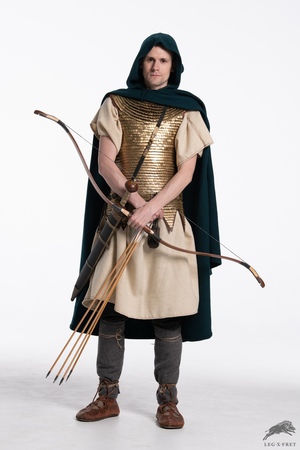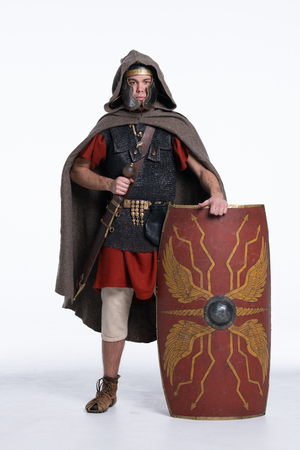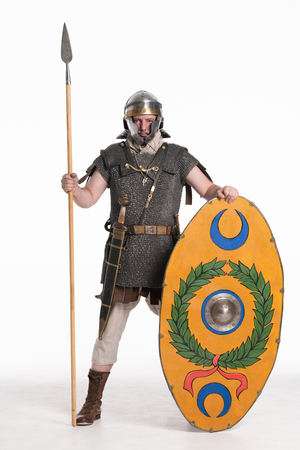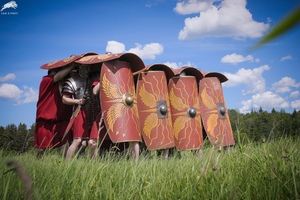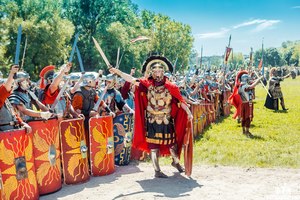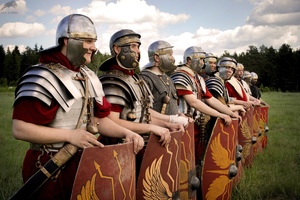Roman Army - literature
This section is devoted to useful literature materials related to the direction of the "Roman Army".
Main reenactment images of the direction:
Recommended literature in this field
In Russian:
NS - Military clothing of Rome 100 DNE-200 NE. pdf
Modern historians pay great attention to the study of Roman armor and weapons, while completely ignoring such an interesting topic as Roman military clothing. Of course, armor and weapons are a very interesting topic, but Roman legionnaires, like modern soldiers, took up weapons relatively rarely, spending much more time in "everyday uniforms" than in "combat equipment". Although the concept of a military uniform did not exist at that time, even without armor and weapons, a warrior was always different from a civilian.
Roman ceremonial and tournament weapons. pdf
This publication examines the evolution of Roman ceremonial, ceremonial and tournament weapons and, mainly, its most representative component-richly decorated elements of armor and helmets with anthropomorphic masks. For the first time in Russian, this book describes Roman richly decorated armor in detail and gives its interpretation based on the extensive material of Western European research in this area, adding new little-known and unpublished finds to the already known collections of artifacts. This story adds a brief excursus with a description of the ceremonies in which this or that type of richly decorated armor was used.
Roman roads construction technology and use in regions during the Republic and early Empire. pdf
This article is devoted to Roman highways of the Republic and Empire eras. In this regard, we study the information of ancient authors, the technology of building Roman roads, the reasons for construction, the rules of use, the impact of a developed road system on the state's economy and foreign policy. Using the example of the Boudica revolt, the article substantiates the position that in addition to the positive results that the developed Roman road network brought to the state, there were also negative ones.
V. A. Shagaev The Army of Rome in the tsarist and Republican periods.pdf
The army of ancient Rome is inseparable from the state. It is the basis of Rome's life, its component element. Roman statehood itself was built on the army principle: clear regulations and strict discipline were inherent not only in the administrative and economic life, but also in the judicial and legal life of Roman society. The connection between the state and the army was clearly expressed by the Roman term " centuria "(Latin centuria – "hundred"), which denoted both a territorial-administrative unit and a military organizational unit. Generals, commanders of various ranks and soldiers were everything to Rome: the foreign policy armed forces, state security and law enforcement agencies, minor officials, firemen, engineers and builders of roads, fortresses, jailers and even caretakers in schools and temples.
In foreign languages:
One of the most feared weapons in the ancient world, the gladius was deadly both on the battlefield and in the arena. Literary sources report the terror it inspired, and archaeological evidence of wounds inflicted attests to its deadly effect. Combining threads of literary, sculptural, and archaeological evidence, renowned expert M. S. Bishop creates a narrative about the development of the gladius, exploring the way the shape of the short sword changed as soldiers and gladiators developed their fighting style. Bringing together historical information, excavated artifacts, and the latest scientific research on blades, this volume reveals the development, technology, training, and use of gladius hispaniensis: the sword that conquered the Mediterranean.
A heavy dart, usually used as a striking weapon just before contact, the pilum was designed with a special specialization: it could penetrate a shield and carry a person behind it. Relying on mass rather than speed, the saw salvo had almost the same effect on the attacking enemy as the firing squad in later periods. The design was heterogeneous, with a wide variety of types throughout the history of weapons development, but for more than four centuries it remained an important part of the arsenal of weapons at the disposal of the Roman legionary. Drawing on recent major finds in the Iberian Peninsula and the Balkans, as well as written documents and careful scientific analysis, this fascinating study lifts the veil on the evolving nature of the pilum, the Roman heavy spear that helped conquer the known world.
Bishop - Roman Military Equipment.pdf
It is often said that Rome's rise to the empire owes much to the efficiency and military prowess of its armies and their technological superiority over barbarian enemies. But how "advanced" was Roman military technology? What is its origin and how did it evolve? The authors of this book have collected a wealth of evidence from across the Roman Empire - excavated examples, as well as graphic and documentary sources - to provide a picture of what range of equipment will be available at any given time, what it will look like, and how it will function. They explore how certain samples were taken from Rome's enemies and adapted to the specific conditions of war prevailing in different parts of the Empire. They also explore in detail the technology of military equipment and the means by which it was produced, and discuss broader issues such as the soldier's status in Roman society. Both the specially prepared illustrations and the text have been completely reworked for the second edition of this detailed and authoritative guide, bringing it in line with the most recent research. It illustrates every element in a Roman soldier's equipment, from his helmet to his boots, his insignia, his tools, and his weapons. This book will appeal to archaeologists, ancient and military historians, as well as general and curious readers.
The Roman Empire depended on the ability of its armies to defend and expand imperial borders, allowing it to dominate much of Europe, North Africa, and the Middle East. Success, in large part, was based on well-trained, well-disciplined soldiers who were equipped with the most advanced weapons and armor available at the time. This is the production history of this armor. Roman Imperial Armor is a study of the metals from which armor was made, how ores containing these metals were extracted from the ground and turned into workable metal, and how this raw product was turned into the armor of the Roman army. Policing and protecting such a vast empire required a large and well-organized force, and the book examines the organization of the army, its size, composition, logistics associated with its deployment and support, and training, rewards, and benefits. he offered his men weapons each.
Ray Laurence-The Roads of Roman Italy Mobility.pdf
The roads of Roman Italy offer a complete reassessment of both the evidence and interpretation of Roman land transport. The book draws on archaeological, epigraphic, and literary evidence from Roman messages, drawing on the latest approaches to the human landscape developed by geographers. Topics covered include: - the relationship between the road and the human landscape - administration and maintenance of the road system - the role of roads as imperial monuments - economics of road construction and urban planning.
Pugio - Gladius brevis est.pdf
Archaeologists are on excavations, they produce finds of ancient artifacts, sometimes complete, but often only fragmentary. This is where the fun begins. These findings should be compared with others from known contexts in order to understand their function and establish their dates. This includes searching through previous publications, in studied journals, which are not always easy to get. When this happens, it is very useful to be able to use a "single" volume-a directory in fact-where many examples are given along with basic facts about them. This is exactly what Marco Saliola and Fabrizio Caprini produced here for the Roman "small arms", pugio. If that was all they produced, it would still be a valuable addition to the archaeologist's toolbox. They have, however, gone much further than that. They studied the history of the weapon, its design, its strengths and weaknesses as a weapon, its likely use, its artistic representation, and they structured the catalog around a useful typology. In short, I would assume that they have performed as complete a study of pugio as possible.
The fort of Newstead in the Parish of Melrose.pdf
Roman Frontier Outpost and its people: Fort Newstead in Melrose County. James Curl, F. S. A. Scot., F. S. A.
Glasgow Publishing House: James Mclehosse & Sons. 1911.
Evidence for horse armour in the Roman Army - Sebastian Schuckelt.pdf
The Roman Army has been a center of research and interest for centuries, with many scholars around the world exploring numerous different areas of this extremely interesting topic. Roman cavalry, however, received much less attention than other aspects of the field. Even among those researchers who have researched this topic, few have considered the use of horse armor in the Roman army and how it would have affected the way Rome's armies operated during the war. Even in works that cover Roman cavalry, the specific theme of Roman horse armor has attracted very little attention.
Roman military equipment from the river Ljubljanica Published by the State Museum of Slovenia in 2019, the catalog of Roman equipment and armaments mainly dating from the 1st century BC to the 1st century AD contains a detailed description, dimensions, sketches, color photographs from different angles, metallographic and PIXE analysis of finds made in the vicinity of the Ljubljana River in Slovenia. Highly recommended reading for reenactors and those interested in this historical period. The catalog is available in two languages - Slovenian and English. It was not published in Russia.
Finds Of The Roman Military Equipment In Croatia Published by the Zagreb Archaeological Museum in 2010, the catalog of finds of Roman equipment, weapons, household equipment, army diplomas and tombstones from different time periods of the Roman Empire. It contains detailed descriptions, dimensions, sketches, and color photographs of finds stored in various museums in Croatia. Highly recommended reading for reenactors and those interested in this historical period. The catalog is available in two languages - Croatian and English. It was not published in Russia.
Masada - The Military equipment Catalog of archaeological finds in the fortress on the shores of the Dead Sea-Masada.
Masada - The Military equipment Catalog of archaeological finds in the fortress on the shores of the Dead Sea-Masada.
Bishop - Roman Shields Roman Shields, Bishop. Another work of the famous British weapons expert and popularizer of Bishop's history, dedicated to Roman shields from tsarist times to the collapse of Western Rome. The work contains a lot of sources, both iconographic and archaeological, as well as narrative, which will be useful for any reenactor who chose the image of the Roman military.
Vindolanda and its textiles Gavvo and his tosseae Vindolanda and Its Textiles, by John Peter Wilde. The work is devoted to the findings of textiles and dyes in the Roman auxiliary fortress of Vindolanda near Hadrian's Wall. More than 700 textile fragments found during the excavations were analyzed.
European Mail "European chain armor", Martijn A. Weinhoven. Extensive work from a leading researcher of European chain armor is devoted, as you might guess, to the finds of chain mail and its elements on the territory of Europe from the Early Iron Age to late antiquity. The work contains an invaluable catalog of finds of chain mail and fragments, which will be a great help for any reenactor who chose chain mail as his armor.
Bishop - Roman plate armour.pdf "Roman plate armor", M. Bishop. Another work of the indefatigable weapons expert, this time dedicated to the most famous Roman armor-Lorica segmentata, hybrid armor, protection of hands and feet. The work contains an extensive body of sources, invaluable for lovers of Roman armor, as well as information on manufacturing technologies and traditions of using plate armor in the Roman army.
Bishop - Roman Mail and Scale Armour.pdf "Roman mail and scale armor", M. Bishop. The famous weapons expert decided to cover all areas of Roman weapons with his pen. This work focuses on chain mail and scales — the most massive armor of the Romans throughout their history. They did not require highly skilled craftsmen, sophisticated machinery, and high-quality raw materials for production and repair, and were less demanding to fit the warrior's figure than plate or muscle armor.
"Spata", M. Bishop. Another work of the famous weapons expert Bishop, dedicated to the spata-a long sword of the Roman cavalry, and from the end of the 2nd century AD. e. and the entire army. The work contains a lot of sources and dispels the stereotype of spata as a rough slashing sword of a barbarian, alien to the correct system and discipline — in fact, the Roman infantry massively adopted spata before the Germans and the latter adopted them from the Romans, and not vice versa.
Cingulum militare Stephanie Hoss.pdf
"Cingulum militare: A study of the Roman Military belt of the 1st-3rd centuries AD", Stephanie Hoss. Article by a leading researcher of the Roman military costume and belts of the imperial period. The author draws on an extensive body of iconographic and narrative sources in an attempt to understand the true meaning of the belt in a military suit, both from a functional, social and aesthetic point of view.
Romische lederfunde aus mainz.pdf A book about shoe finds in Mainz. It contains information about caligas and calcae, their cut and structural features.
Auxiliaries:
Auxiliaries Cantoborum article.pdf
"Cantabrum" is a variation of the Roman military standard. Some of the Latin-Christian literary sources speak of it, it is well known, to which we will now add the Greek text of Ps. Justin, Aquincum inscription, in Pannonia, dating from the third century AD, as well as Gallienus coins with the legend I. O. (vi) Cantab (rurum). We also collect and update inscriptions on Cantabrorum cohorts, as well as literary and epigraphic texts related to "cantabricus gyrus". All these Documents allow us to reflect on various relevant Quaestiones cantabricae and make new suggestions.
In the deep crisis that Syria faced in the early 1st century AD, the Arab population, namely the Nabataeans and Iturians, dominated the regions they occupied at that time. The latter were also attested in the mountainous regions of Phoenicia and southern Syria, territory that Augustus gave to the Herod family. In 49 AD, after the death of Sochemus, according to Tacitus (Annales XII, 23), the kingdom of Iturea was incorporated into the province of Syria. The recruitment of Iturian archers has been documented since the First Civil War. Caesar often used mounted and infantry archers, calling them "sagitarios Ityreis Syris et cuiusque generis". Pompey preferred archers from Crete, Lacedaemonia, and Pontus. The extremely difficult problems that the Roman administration faced with the warring Iturians during the reign of Augustus were mentioned in both literary and epigraphic sources. Around the same time, two veteran colonies were established: Berit and Heliopolis. Isaac believes that these colonies played a strategic role, since the Roman administration faced banditry in the mountainous areas, which poses a real danger to commercial routes.
Auxilia Moesiae Superioris.pdf
The publication of recently discovered Roman military diplomas now allows us to determine more precisely the deployment pattern of auxiliary units, both in Upper Moesia and Dacia, and later in Upper Dacia and Porolissensis. Because the auxiliary units in the newly conquered province of Trajan were moved from Upper Moesia. Our findings also cover the Dacian provinces. In addition, it is now also possible to see the important influence of the transformation of the Dacian province and Trajan's Parthian war on the distribution of military units located on the Roman border, starting from Pannonia (and not only, also from Britain and Germany). ) to the Black Sea and further east. Therefore, the purpose of this document will be to provide an overview of the deployment of support units located in Upper Moesia and Dacia, from Domitian to Hadrian, when the defense system was established.
Actium Allies and the Augustan Auxilia.pdf
Augustus ' military reforms are a major theme of Roman military history. As with many subjects of military history, this topic also has a meaning that goes far beyond the limited scope of studying the Roman army in the strict sense of the word. This sheds a lot of light on the strategy of the Roman Empire in relation to the peoples it rules and the conditions it sets for their integration. The question influences attempts to understand how Imperial Rome developed from its previous republican structure, and how it exploited its provincial resources without critically destroying internal cohesion. Republican Rome used an increasing number of foreign troops, replenishing and strengthening its army with civilians in the legions. Such troops supporting legions were usually referred to as auxiliaries and included cavalry and lightly armed infantrymen, as well as special forces. Since the end of the social war in 88 BC, when Rome incorporated the Italian Socia into its civil units, the foreign auxilia formed the main secondary branch of the Roman Army.
Les Archers de Cesar - Guillaume Renoux - Tome 1.pdf, Les Archers de Cesar - Guillaume Renoux - Tome 2.pdf
The book is dedicated to the auxiliary infantry-archers and their evolution in the army of Ancient Rome. Historical, archaeological and paleometallurgical studies of archers in the Roman army and their armament from the period from Caesar to Trajan are described in this book.

 Gallery
Gallery






